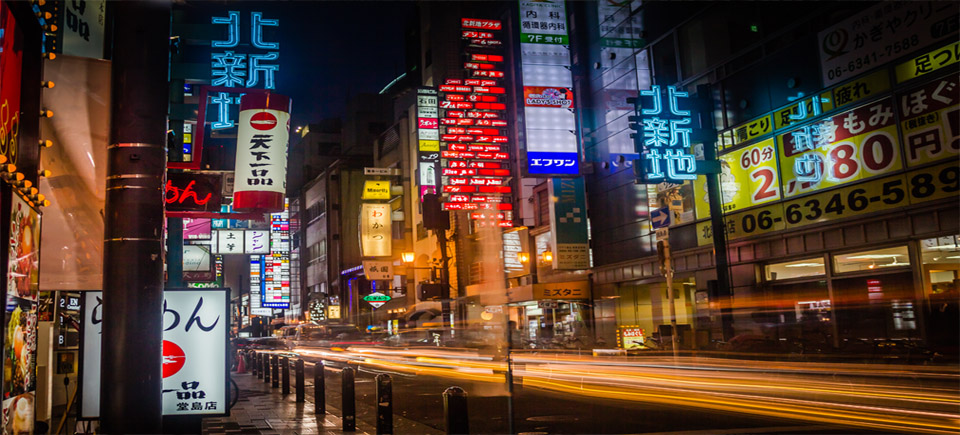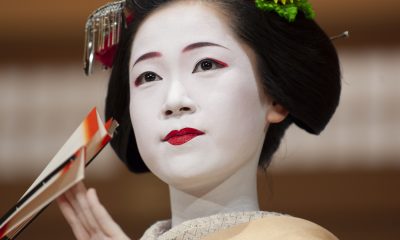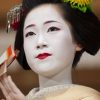Feature
The Feasts and Fortunes of Glitzy Kitashinchi
An elite entertainment district in the heart of Osaka, Kitashinchi is quirky, kitsch and classy all at once. Narrow streets brightly lit with neon signs and flashing billboards, it’s a place that wants your curiosity to get the better of you.
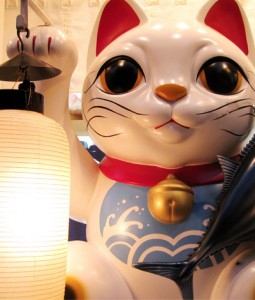 Explore the streets for free, but going deeper into this neon kaleidoscope could cost a pretty penny. There are many wonderful things in Kitashinchi and all of them come with a premium price tag. This narrow rectangle of streets, sandwiched in beneath Umeda’s central business district, is one of the more famous of the hanamachi (pleasure districts) in Japan. Its customer base is the executive elites, those who manage and own the nearby, glittering office towers. They come to wine and dine clients, or their girlfriends, after a hard day’s work.
Explore the streets for free, but going deeper into this neon kaleidoscope could cost a pretty penny. There are many wonderful things in Kitashinchi and all of them come with a premium price tag. This narrow rectangle of streets, sandwiched in beneath Umeda’s central business district, is one of the more famous of the hanamachi (pleasure districts) in Japan. Its customer base is the executive elites, those who manage and own the nearby, glittering office towers. They come to wine and dine clients, or their girlfriends, after a hard day’s work.
But Kitashinchi isn’t just for those to whom money is no object. Walking the streets is still free, and casual visitors heading there on weeknights, from around 7pm til midnight, can get a feel of the unique atmosphere and energy of a Japanese entertainment district. On Saturdays and Sundays, however, Kitashinchi is dead; closed like the offices around it.
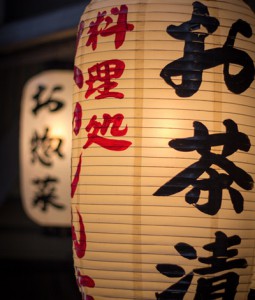 While there are no overt attempts to attract foreign visitors, this is not an exclusionary area, and for those with the funds, it boasts some of the finest culinary experiences in Japan. The cost, more than the language barrier, however, keeps most foreign tourists at bay. Of the hundreds of restaurants here, many fall into the category of high-class dining: kappo and kaiseki banquet style, and the sushi here is definitely not travelling around on a conveyor belt.
While there are no overt attempts to attract foreign visitors, this is not an exclusionary area, and for those with the funds, it boasts some of the finest culinary experiences in Japan. The cost, more than the language barrier, however, keeps most foreign tourists at bay. Of the hundreds of restaurants here, many fall into the category of high-class dining: kappo and kaiseki banquet style, and the sushi here is definitely not travelling around on a conveyor belt.
Even though it was once decimated by war, and despite its modern-day walls-of-neon streetscape, Kitashinchi feels like it reaches into the past for its style. This area was once an island between the Sonezakigawa and Dojimagawa Rivers, and was called Sonezaki Shinchi. It was where geisha charmed their customers with elegance, genteel service, dance and song, and that is still very much the mood that lingers over this whole place.
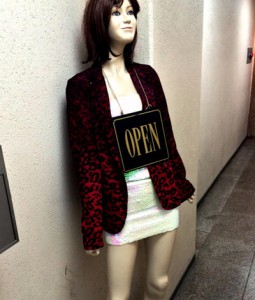 Even in some Western-style venues, with their wood-topped bars and well-dressed waiters, the feel is decidedly early 20th century; reminiscent of a time when evenings out were a special, expensive event. One such venue is Vin-Vino, where wonderfully friendly, vest-and-buttoned staff serve snacky, delicious, organic dishes, and a wide variety of wine, sake, and aged Nihonshu. The atmosphere is very relaxed, yet special, and the dress code calls more for a cocktail dress than jeans.
Even in some Western-style venues, with their wood-topped bars and well-dressed waiters, the feel is decidedly early 20th century; reminiscent of a time when evenings out were a special, expensive event. One such venue is Vin-Vino, where wonderfully friendly, vest-and-buttoned staff serve snacky, delicious, organic dishes, and a wide variety of wine, sake, and aged Nihonshu. The atmosphere is very relaxed, yet special, and the dress code calls more for a cocktail dress than jeans.
There is good food, and many a welcoming face behind doorways in Kitashinchi, however it remains an entertainment district with a purpose. The flower shops here cater to kyabakura (hostess club) decor, rather than couples out on romantic first dates. Invite-only sanctums fill the upper levels of the buildings.
On a typically busy Thursday night, the main road is likely to be buzzing with hostesses in kimono-clad elegance, or a more blatant short-skirt suggestiveness. There will be clumps of cheerful businessmen out for a good night. Stretch hummers can also frequent, navigating obliviously through it all at below walking speed, while a party pumps loudly inside.
Security, though young and friendly, bar entry to some doors, while in the background, older, grimmer guards watch strangers and mutter, expressionless, into their headsets. While I was chatting with one of the former, he admitted that working Kitashinchi is a tough lifestyle, with his mornings starting at 3pm, and days ending with the sunrise. He said, after 18 months, he is looking at other options.
Of course, as in all places where alcohol is imbibed and sex is for sale, visitors should take sensible precautions. While Kitashinchi can feel as safe as the rest of Japan, travelling with a friend is a good idea, as is knowing what kind of establishment you are entering before you actually go inside. Street photography, especially candid shots of the hostesses or their customers, is strictly prohibited.
There is a glamour to visiting Kitashinchi; an alluring area, almost like movie-set Japan in the way that other urban neighbourhoods like Dotombori and Gion are. It can be enough just to walk through the area on a weeknight and people-watch for free. On very special occasions, or for those searching for culinary excellence, a meal in one of Kitshinchi’s sushi, kaiseki or kappo establishments may be the Mecca of your particular pilgrimage. However, beware, it might also be the beginning of an expensive obsession.
Take American visitor Jason Frocht for example. He wandered into Kitashinchi, and his first kaiseki restaurant, during his first few months as an exchange student in Japan. He drifted in as a poor student about to become a lot poorer. One banquet later, and his monthly grocery budget blown, an obsession was born. He noticed a trend, or a warning, for choosing restaurants in Kitashinchi; those with fountains, stone lanterns, or little gardens at the front will destroy your wallet. Jason is part explorer, part academic, and altogether devoted to delicious food. His personal Kitashinchi tour and recommendations for restaurants, ranging from the slightly expensive to the possibly once-in-a-lifetime, are the subject of this month’s Adventures In Kansai video (kansaiscene. com/category/video).
One of Jason’s particular recommendations is Geppa Kaiseki, a counter kaiseki restaurant which serves fabulous, seasonal sets starting from ¥7,500. This restaurant is recommended as great value for an experience that will linger long in your mind and on your taste buds. Consider your wallet forewarned.
• Access: Walk south (less than 10 minutes) from Osaka Stn, Umeda Stn, or Nishi-Umeda Stn.
• Prices: Though some ramen and kushi-katsu shops exist with the usual prices, this is an expensive area. Expect many meal sets to start at ¥8,000.
• Photos: Photography of hostesses and their clients is not only frowned upon, it could get you sued.
• Safety: Mixed in among the genteel dining are hosts and hostesses, snack bars and girls’ bars. Late at night, when lots of drunk businessmen are on their way out, it is best to make sure to travel with a friend.
[box]
Food Options for the Newbie
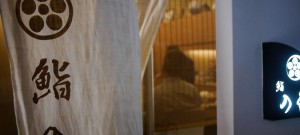 • Kappo: Rumoured to have originated in Osaka, customers sit along a counter, directly across from the chef and can watch as their meal is prepared. Presentation, technique, conversation, and many small, exquisite courses are all part of the kappo experience.
• Kappo: Rumoured to have originated in Osaka, customers sit along a counter, directly across from the chef and can watch as their meal is prepared. Presentation, technique, conversation, and many small, exquisite courses are all part of the kappo experience.
• Kaiseki: A multi-course feast, considered by some to be the pinnacle of Japanese cuisine. Foods and flavours tend to be simple, seasonal, and though often rare, including delicacies like fugu (puffer-fish); its flesh arranged on the plate like chrysanthemum petals.
• Sushi: Sushi-ya in Kitashinchi are omakase (“It’s up to you”) types, where the customers entrust their chef to choose their fish. There are several Michelin-starred sushi restaurants tucked away here, though many require reservations.
• Sushi Sougorou is an omakase sushi restaurant recently opened in Kitashinchi. Along with the sashimi comes conversation and stories, as the chef strives to build a personal connection with his customers, and serve them the perfect meal. This is not the place for anonymous, quick eating, nor is it cheap – courses start at ¥8,000. The chef noted that many foreigners walk through Kitashinchi, but never stay for dinner. Too expensive.
[/box]
北新地の不思議
大阪の真ん中にある、日本屈指の高級歓楽街。北新地はいつも怪し気で、 キッチュで、お高くとまっている。狭い路地を埋め尽くす、ケバケバしいネオ ンの洪水。ここには人の自制心を揺るがす魔力がある。
一度は戦争で焼け野原となった。ネオンで飾られた街並みは現代の猥 雑さを映している。それでも北新地には、古き良き時代を偲ぶ独特のスタ イルがある。ここはもともと曽根崎川と堂島川に挟まれた島で、曽根崎新 地の名で呼ばれていた。かつては芸姑たちが踊りや唄で優雅に旦那衆を もてなした花街であり、その面影は今でも街全体に色濃く残っている。
西洋風の店においても、懐古調は主流だ。木造りのカウンターと正装 したウエイターは明らかに20世紀前半の風情で、夜の社交が特別に高 価だった時代の名残りをとどめている。そんな店のひとつが「ヴァンヴィ ーノ」。ベストをきちんと着こなした感じのよい店員が、気の利いたスナッ ク、美味しいオーガニック料理、バラエティ豊かなワイン、日本酒、古酒な どを出してくれる。ゆったりとした雰囲気だが、それでいて特別な場所に いる華やぎもあり、ジーンズよりもカクテルドレスが似合う場所だ。
ドアの向こうでは、美味しい料理や上質なサービスが迎えてくれる 北新地。それでもある種の欲望が渦巻く大歓楽街であることには違いな い。この街の花屋は、初デートのカップルに売る花束ではなく、キャバク ラやホストクラブの飾り付けが本業だ。スナックビルの上層階にいくほ ど、一見さんお断りの聖域が軒を連ねている。
賑やかな木曜の夜に北新地へ行けば、メインストリートでは艶やかな 着物姿やミニスカートのホステスたちが忙しく行き交っている。陽気なビ ジネスマンの集団が、夜のお楽しみを求めて繰り出す姿も見られるはず だ。豪勢なハマーリムジンもよく現れる。街の喧騒をよそに歩行者よりも ゆっくりと街を流し、車内からはパーティーの賑やかな音が聞こえてくる。
店先の路上では、若い客引きの男たちが愛想を振りまいている。後 方では、それよりやや年長のいかつい門番が、無表情でヘッドセットマ イクに何かをつぶやいている。客引きの一人と立ち話をしたが、北新地 で働く生活は楽じゃないそうだ。仕事は午後3時から始まって夜明けま で続く。もう18ヶ月も続けているが、他の仕事を探している最中なのだ という。
もちろん、酒と性が商われる街の常として、訪問者にはあらかじめ知 っておくべき注意事項がある。北新地は日本の他の場所とも同様に安全 だが、友達と連れ立って行くのが賢明である。そして実際に店に入る前に は、どんな店なのかを確かめてから入ったほうがいい。また、路上でホス テスや客を隠し撮りするような行為は厳禁である。
道頓堀や祇園にも共通する、映画のセットのように美しい日本の都市 風景が北新地にはある。平日の夜、路地を歩いて人々の様子を眺めるだ けでも十分に楽しい。特別な記念日の晩餐や、美食体験を求める人にと っては、北新地の寿司、懐石、割烹の店が終着の地となるかもしれない。 ただしその値段のせいで、外食恐怖症にならないように注意しよう。
アメリカ人旅行者、ジェイソン・フロクトの例がある。貧しい交換留学生 だった彼は、まだ来日して間もない時期に、初めて歩いた北新地でふらり と懐石料理の店に入った。ひと晩でひと月分の食費を失った彼は、北新 地の飲食店からさまざまな警告信号を読み取るようになったのだという。 噴水、石灯籠、箱庭が店先にある店は破産直行なので注意。冒険心と向 学心を美食の探求に注ぐジェイソンは、今月のAdventures In Kansai の動画(kansaiscene.com/category/video)でも北新地でおすす めのお店を紹介している。
ジェイソンが特におすすめする店のひとつは、カウンターで素晴らし い季節の懐石料理が食べられる「月波」だ。季節のコースは7,500円か ら。心にも味覚にも長く記憶される、お値打ちの体験ができるとのこと。 財布と相談してみよう。
• アクセス:大阪駅、梅田駅、西梅田駅から南へ徒歩10分以内 。
• 予算:普通のラーメン屋や串かつ屋もあるが、高価なエリアであること は間違いない。多くのコースメニューは最低8,000円から。
• 写真撮影:ホステスや客を撮影すると、顰蹙を買うばかりか訴えられる 可能性もある。
• 安全:一般の食事処に混じって、クラブ、ホストクラブ、スナック、ガー ルズバーなどがある。酔っ払いのビジネスマンが行き交う深夜には、友 達と一緒に行動するのが無難。
[box]
初心者向けグルメ指南
• 割烹 – 大阪発祥という説もあり、客がカウンターに並んで料理 人の仕事を間近に見られる店。料理の出し方、調理技術、会話、 繊細な小皿料理のすべてが、かけがえのない割烹体験となる。
• 懐石 – 日本料理の頂点と考える人も多い贅沢なフルコース。シ ンプルな味付けで、季節の味覚をじっくり楽しむ。運良くタイミン グがあえば、美しいフグの薄造りなどの名物も味わえるだろう。
• 寿司 – 北新地では、ネタの選択をすべて職人に一任する「おま かせ」が主流。ミシュランで星を獲得した店も何軒かあるが、多く は予約が必要な人気店だ。
• 寿司 惣五郎 は、北新地に最近オープンした「おまかせスタイ ル」の寿司屋。刺し身ひとつひとつを丁寧に説明してくれる。客 の好みを理解することで、完璧な食事を提供しようという料理 長の方針だ。一見客向きではなく、食事だけして帰るような店で もない。もちろん安くない。コースは8,000円から。料理長いわ く、外国人は北新地を歩くだけで夕食をしない。 値段が高すぎ るんだろうね。
[/box]


